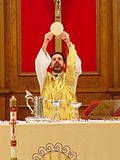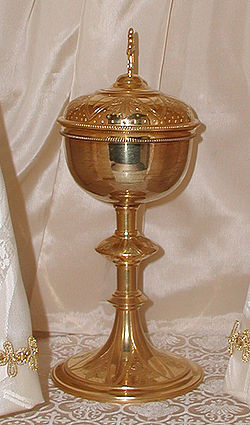- Ciborium (container)
-
A ciborium (plural ciboria; Latin from the Ancient Greek κιβώριον (kibōrion)[1]) is a vessel, normally in metal. It was originally a particular shape of drinking cup in Ancient Greece and Rome, but later used to refer to a large covered cup designed to hold hosts for, and after, the Eucharist, thus the equivalent for the bread of the chalice for the wine. The word is also used for a large canopy over the altar, which was a common feature of Early Medieval church architecture, now relatively rare.
History
The ancient Greek word referred to the cup-shaped seed vessel of the Egyptian water-lily nelumbium speciosum and came to describe a drinking cup made from that seed casing,[1] or in a similar shape. These vessels were particularly common in Egypt and the Greek East. The word "'ciborium'" was also used in classical Latin to describe such cups, although the only example to have survived is in one of Horace’s odes (2.7.21–22).[2]
In medieval Latin, and in English, "Ciborium" more commonly refers to a covered container used in Roman Catholic, Anglican, Lutheran, and related churches to store the consecrated hosts of the sacrament of Holy Communion. It resembles the shape of a chalice but its bowl is more round than conical, and takes its name from its cover,[clarification needed] surmounted by a cross or other sacred design. In the early Christian Church, Holy Communion was not kept in churches for fear of sacrilege or desecration. Later, the first ciboria were kept at homes to be handy for the Last Rites where needed. In churches, a ciborium is usually kept in a tabernacle or aumbry. In some cases, it may be veiled (see photograph below) to indicate the presence of the consecrated hosts. It is typically made, or at least plated, in a precious metal.
Other containers for the host include the paten (a small plate) or a basin (for loaves of bread rather than wafers) used at the time of consecration and distribution at the main service of Holy Eucharist. A pyx is a small, circular container into which a few consecrated hosts can be placed. Pyxes are typically used to bring communion to the sick or shut-in.
Notes
- ^ a b OED.
- ^ Horace, Odes II: Vatis Amici, tr. and ed. by David Alexander West (Oxford: Clarendon Press, 1998), p. 53.
External links
 The Wiktionary definition of ciborium.
The Wiktionary definition of ciborium.Order of the Divine Service in Lutheranism Preparatory Service Entrance hymn and Trinitarian formula (known as the Invocation) · Penitential Rite including the Confiteor and Declaration of Grace (or Asperges on Easter)
The Service of the Word Introit · Gloria Patri · Kýrie · Gloria · Dominus Vobiscum · Oremus · Collect · Old Testament reading · gradual (or Responsorial Psalm) · Epistle · Alleluia (tract during Lent) · Gospel · Hymn of the day · Homily or Postil (Sermon) · Nicene Creed (Athanasian Creed on Trinity Sunday) · Offertory · Prayers of the FaithfulThe Service of the Eucharist Preface (Sursum corda / Sanctus / Hosanna) · Eucharistic Prayer (Epiclesis / Words of Institution / Memorial Acclamation) · Lord's Prayer · Sign of peace / pax (elevation) · Agnus Dei · Distribution · Nunc dimittis · Postcommunion · Benedicamus Domino · Benediction · Dismissal · Ite missa estParticipants Parts of the Sanctuary altar · altar bell · altar crucifix · altar rails · kneeler · piscina · processional cross · tabernacleCandles Liturgical vessels Liturgical objects collection basket · holy water · incense (use) · paten · sacramental bread (wafer) · sacramental wine · thuribleVestments Liturgical books and hymnals Agenda · Evangelical Lutheran Hymn-Book · Evangelical Lutheran Worship · Lutheran Book of Worship · Lutheran Hymnal · Lutheran Hymnal with Supplement · Lutheran Service Book · Lutheran Worship · Service Book and Hymnal Lutheranism PortalCategories:
Lutheranism PortalCategories:- Catholic liturgy
- Drinkware
- Eucharistic objects
- Lutheran liturgy and worship
- Metalworking
- Christianity stubs
Wikimedia Foundation. 2010.



